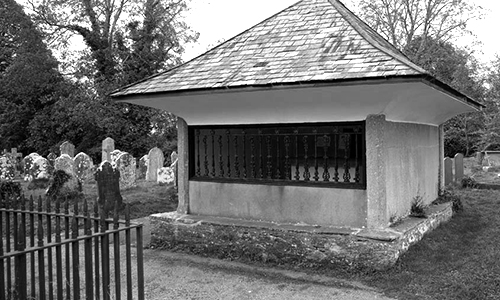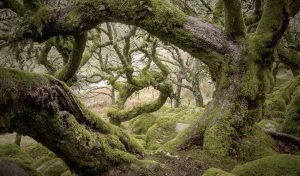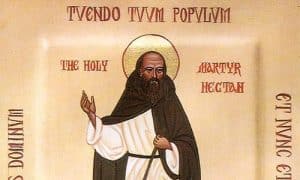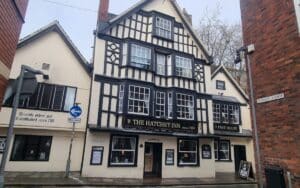Guest writer MARK NORMAN looks at the dark legend surrounding the ‘evil’ Squire Richard of Devon, including black dogs!
The history and folklore of the South West is littered with characters of dubious reputation. Sometimes they achieve notoriety from their actions: smugglers, pirates or highwaymen for example.
Sometimes, it comes about because of their lifestyle choice, as it was with the ‘evil’ Squire Richard Cabell.
Richard Cabell, The Man
Richard Cabell was the local squire at Buckfastleigh, Devon, in the 17th century and was a much disliked man. The parish of Buckfastleigh sits on the edge of Dartmoor and runs northwards up the great slopes of the area.
The landscape here is scored by long, deep, narrow valleys which were cut over thousands of years by the many streams hurtling down to join the River Dart.
Tucked away in these remote areas are mysterious little old farms, manors and cottages including one named “Brooke”. It was here that Squire Cabell lived, and died on 5th July, 1677.
Although it is not recorded exactly how he came by his dark reputation, folklore various tells that he was a hunter of village maidens (it is certainly true that he was a passionate huntsman and his quarry may have extended further than foxes) and also that he was both immoral and that he sold his soul to the Devil.
One further rumour also told that Richard Cabell murdered his wife, though it is not known what the circumstances behind this were.
Upon his death, the local people were left with a decision to be made… how best to bury such an evil character safely so that his spirit would not rise up and continue to plague them in death as he did in life?
The Burial
Squire Cabell’s body was interred in the graveyard at Holy Trinity Church, perched atop a hill overlooking the town of Buckfastleigh and was placed in an altar tomb outside the south door of the church.
This still surviving structure is known locally as the ‘sepulchre’ and is more akin to a prison than a grave, albeit a symbolic one.

The parishioners first buried Cabell deeply in the earth and then placed a heavy stone upon his head. Once the grave had been filled they placed the building on the top. The structure is solidly built and has a wide iron grill on the side facing the church. On the opposite side is a strong wooden door with a locked keyhole.
The Legends
Naturally with a character such as this a number of legends have formed around these events. One thing that is certain is that Squire Cabell is intrinsically linked to Black Dog folklore in the area and, particularly, to the traditions of the Wild Hunt.
In one version of this folklore it is said that Cabell was chased across the moor by the Whisht Hounds (a local variant of the Dogs that accompany the Wild Hunt) until he dropped dead. Another version says that as he lay dying in his house, the hounds bayed outside. This latter version could be seen as being a death warning – one of the many aspects of Black Dog symbolism in folklore.
A third version of the tale relating to the Black Dogs tells that on the night that he was buried crossed the moor to stand at howl at his tomb and, that they returned there often when they were not out hunting.
In fact, this led to his becoming one of the many people cited as leaders of the Wild Hunt, taking the pack across the moors each year on the anniversary of his death.
As a conclusion to this variant of the story, the tomb was said to have been constructed in order to lay his disturbed soul to rest and separate him from the Hunt.
The curious nature of the altar tomb has also led to legends of its own. Some people have reported that a red light has been seen behind the bars inside the structure.
Others have said that demons come to the tomb in a vain attempt to retrieve the soul of the Squire for their master (to whom you will recall it is said that he may have sold it).
Young boys used to dare each other to walk clockwise around the building thirteen times before inserting a little finger into the keyhole of the wooden door, which the prisoner was then said to gnaw at the tip. This is an example of a typical playground ghost-type game in the same vein as “Bloody Mary” or “Candyman”.
Destruction of the Church
The Church of Holy Trinity has been damaged many times over the years and now only the shell remains. On May 8th 1849 arsonists set a fire which destroyed the vestry as well as various items within the building and part of the roof.
Bombing during World War Two shattered some of the stained glass windows and, finally, the entire building was gutted by fire in 1992. Again, this was the result of an arson attack which was blamed on Satanists, although there has never been any evidence for this. The site was rumoured to have been used for magical rites for many hundreds of years.
Links to the Baskervilles
For many years it has been debated from where Sir Arthur Conan Doyle drew his inspiration for the story of the Hound of the Baskervilles.
Richard Cabell is one character who has been linked as a possible source, as local tradition credits him with a reputation not unlike Black Hugo in the novel. But I will examine this and other possible sources for the Baskerville Hound in a future article.
MARK NORMAN is a folklore researcher and writer who lives on the edge of Dartmoor, in Devon. He is a committee member of the Folklore Society and also of the Friends of the Museum of Witchcraft and Magic. Mark writes on the folklore of the South West but his specialist area of interest is in the study of Black Dog folklore. To follow Mark’s research and contact him, please follow him on Facebook or on Twitter at @Mr_Mark_Norman






